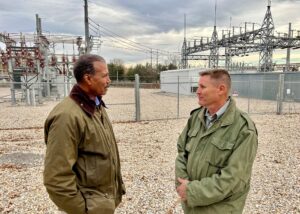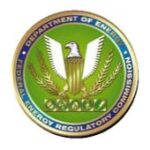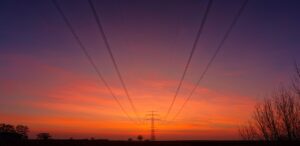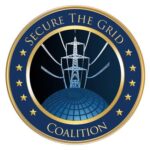The electric grid is essential to all of our lives
Every human being in the U.S. is literally on life support - plugged in to the electric grid. If somebody unplugs us, everything necessary to sustain our human population stops: food, water, fuel, transportation, medical, communications, financial—everything. The electric grid is vulnerable to numerous threats and we know (from this Senate report) that in a long-term national-scale blackout, millions of U.S. citizens could die. After only a few weeks, we would die in droves from waterborne diseases, starvation and societal collapse. And what if the grid went down for longer than a few weeks?
But let's back up. What is the electric grid and how is it regulated?
What is the electric grid?

First of all, the North American electric grid is an amazing human accomplishment. It is the largest machine in the history of the world, built piece by piece over many generations.
But what is it exactly? The "grid" is actually thousands of companies, both public and private sector, that operate in an interconnected system to facilitate the generation, transmission and distribution of electrical power. (No one company owns "the grid"—literally thousands own pieces of it!) The grid is made up of power generation—such as nuclear, coal and gas-fired power plants, wind turbines and solar farms, high voltage transmission lines that span long distances across the country and local distribution lines which bring the power from the street to your house.
- Click HERE for a graphic representation of the grid.
- Click HERE for a government primer on the electric grid.
This interconnected—and vulnerable—patchwork is what allows the United States to support her human population. Everything that enables 330 million people in the country to survive is wholly reliant on the grid. All of our critical infrastructures—food, water, fuel, transportation, financial, communications and medical systems are all 100% dependent on the grid.
How is the grid regulated?
 Much of the grid is self-regulated (similarly to Wall Street). The federal government under current law can’t tell “the grid” what to do. The North American Electric Reliability Corporation (NERC) is a not-for-profit corporation. It acts as the self-regulatory organization “whose mission is to assure the reliability of the bulk power system (BPS) in North America.” The Federal Energy Regulatory Commission (FERC) is an independent federal agency that regulates the interstate transmission of electricity, natural gas, and oil. FERC’s specific authority over the electric grid is to “oversee the reliability of the bulk power system.” The regulatory scheme of the grid between NERC and FERC is mind-numbingly complex. (Just the way most industries prefer their relationship with the federal government to be.)
Much of the grid is self-regulated (similarly to Wall Street). The federal government under current law can’t tell “the grid” what to do. The North American Electric Reliability Corporation (NERC) is a not-for-profit corporation. It acts as the self-regulatory organization “whose mission is to assure the reliability of the bulk power system (BPS) in North America.” The Federal Energy Regulatory Commission (FERC) is an independent federal agency that regulates the interstate transmission of electricity, natural gas, and oil. FERC’s specific authority over the electric grid is to “oversee the reliability of the bulk power system.” The regulatory scheme of the grid between NERC and FERC is mind-numbingly complex. (Just the way most industries prefer their relationship with the federal government to be.)
Just to add another layer of complexity, the bulk power system consists of approximately 1,500 entities operating at 100 kilovolts or higher which are regulated by NERC, overseen by FERC. However, the bulk power system does not include distribution to end-users. Distribution is under the jurisdiction of state public utility commissions. This means that there are over 60 state and federal government agencies as well as a number of non-profit corporations involved in the regulation of the electric grid. Talk about herding cats! Finally, there are almost incomprehensible complexities in the regulation of electricity markets. (Click HERE for a great explanation of this archaic system. I take no responsibility if your head explodes!)
The Energy Policy Act of 2005 added Section 215 to the Federal Power Act. This gave FERC the authority to certify an organization as an “Electric Reliability Organization” (ERO) which would develop reliability standards for the industry, subject to FERC’s approval. Yes, you read that right—the industry writes its own reliability standards.

On July 20, 2006, FERC certified NERC as the ERO. Other entities objected and administrative appeals and litigation ensued. Section 215 does give FERC the authority to “upon its own motion or upon complaint, may order the Electric Reliability Organization to submit to the Commission a proposed reliability standard or a modification to a reliability standard that addresses a specific matter if the Commission considers such a new or modified reliability standard appropriate to carry out this section.” In English, FERC can direct NERC to develop a particular standard and submit it for FERC’s review and approval, but this again is very time consuming.
Here's an example of how time-consuming the regulatory process is. The “Great Northeast Blackout" of August 14, 2003 was caused by inadequate vegetation management (i.e., a tree branch in Ohio). This started a cascading failure which resulted in 55 million people out of power - almost the entire northeastern U.S. and part of Canada. This blackout was the direct impetus to come up with a standard for vegetation management. It took the industry and FERC until March 21, 2013—nearly a decade—to establish and approve a final rule for “Transmission Vegetation Management” (FAC-003-2). In fact, the preamble to the 2013 final rule notes:
"A recurring cause in many blackouts has been vegetation-related outages. In fact, one of the initiating causes of the 2003 Northeast blackout was inadequate vegetation management practices that led to tree contact."
Who funds and controls NERC?
 NERC’s annual funding is provided through assessments to the entities that it regulates. Moreover, although technically anybody can become a “member” of NERC, the membership structure stacks the deck in favor of the electric industry as far as the election of NERC’s “independent trustees” (the board that governs NERC). NERC accomplishes this shell-game by assigning all members to one of 12 groups. According to NERC rules:
NERC’s annual funding is provided through assessments to the entities that it regulates. Moreover, although technically anybody can become a “member” of NERC, the membership structure stacks the deck in favor of the electric industry as far as the election of NERC’s “independent trustees” (the board that governs NERC). NERC accomplishes this shell-game by assigning all members to one of 12 groups. According to NERC rules:
“Each member will join only 1 of 13 industry sectors, members of sectors 1-12 elect sector representatives on the NERC Member Representatives Committee (MRC). The MRC elects NERC's independent trustees, votes on amendments to the bylaws, and provides advice and recommendations to the Board with respect to the development of annual budgets, business plans and funding mechanisms, and other matters pertinent to the purpose and operations of NERC.”
So what are the “13 industry sectors?”
1. Investor-owned utility
2. State/municipal utility
3. Cooperative utility
4. Federal or provincial utility/Federal Power Marketing Administration
5. Transmission-dependent utility
6. Merchant electricity generator
7. Electricity marketer
8. Large end-use electricity customer
9. Small end-use electricity customer
10. Independent system operator/regional transmission organization
11. Regional entity
12. Government representatives
13. "Associate" (Non-voting. The public gets herded into here)
In other words, two sectors are customers and one is the government. The other nine are the electric industry. The electric industry gets 9 votes—the customers and the government get 3. If that is not a stacked deck, I don’t know what is. So NERC is literally funded, run and its leadership elected by the electric utility industry that it allegedly regulates. If the grid does not want to be regulated, it has means to resist being regulated.
And by the way, "customers" does not mean "customers." If you are a regular citizen, like me, you are not allowed to join the 12 voting sectors! You will be duffed off to a non-voting sector ("Sector 13"), and thus, the industry has snuffed out the public voice.
Thus, FERC (the government) can’t easily tell NERC (the industry) what to do. Moreover, in this structure, the "ratepayers" have little voice. But the need to secure the grid and the dependent critical infrastructures is a national security issue—an issue of survival for families and the country.
Believe it or not, the grid is actively fighting efforts to (ahem) protect the grid. We have seen this lately in the fight for cybersecurity regulations, as well as the fight for EMP and GMD protections. We have also exposed a massive coverup of cybersecurity violators which endangers us all.
It gets worse.
Who pays for the lobbyists who fight against electric grid security?
If you are an electric customer and pay an electric bill, you are paying for NERC and thinly veiled industry lobbying groups like the Electric Power Research Institute (EPRI) and the Edison Electric Institute (EEI). Both of these groups are funded by the electric utility industry (which is funded by you) and both EPRI and EEI have been stumbling blocks in protecting the electric grid.
Put simply and bluntly, when you pay your electric bill, you are paying for an army of lawyers and lobbyists who are fighting against stricter grid security regulations and lobbying against protecting your family from a catastrophic national-scale power outage.
In fact, according to The Center for Responsive Politics, the electric utilities in 2020 (as of today):
-
- Spent $108,468,019 on lobbying
- Made total contributions of $28,562,003 (including soft money and PACs)
- Made $11,626,034 in political contributions to members of the House
- Made $5,140,906 in political contributions to members of the Senate
- Total lobbying and contributions? over $137 Million
I am often asked "why don't they fix grid security?" Let me give you a billion reasons. Here is what the electric utility industry has spent in the past decade to influence the regulatory environment:
- Federal Lobbying in the past 10 years: $1.2 Billion
- Federal Political “contributions” in the past 10 years: $149.5 Million
Where did all this money come from? Your electric bill. Congratulations. You are paying to lobby against your family's safety.
Perhaps the most disturbing thing about this whole scheme is that there is no federal law that says that the grid has to protect itself from hazards and threats. In fact, as previously noted, “itself” is thousands of separate companies that regulate themselves through NERC. Our very survival is dependent on the industry’s willingness to do the right thing. They are not required to do the right thing. The industry will occasionally do the minimum that they feel they have to do to avoid the government getting off its slow and lumbering buttocks and doing something drastic to protect the grid – and the United States – from catastrophe.
 But is the minimum enough to protect your family and the security of the United States?
But is the minimum enough to protect your family and the security of the United States?
Many of us in the Secure The Grid Coalition believe that it is not. It is time for the federal government (FERC) to step up and insure that we secure the grid from threats such as EMP, GMD, cyber-attacks, physical attacks, extreme weather and errant tree branches.
What Can We Do To Secure The Grid?
We can all get involved and be heard! Federal agencies are required by law to follow procedures when implementing or changing regulations. One requirement is the agency must allow public comments and must consider the comments they received. Also, interested persons can petition a federal agency to start the rulemaking process on an issue.
For example, the Foundation for Resilient Societies petitioned FERC on January 13, 2017 to institute rulemaking because the U.S. electric grid is vulnerable to cyber threats and the current regulations did not adequately address the threats. This petition was met with instant opposition from the electric industry. Not surprising.
However, citizens made a difference. When FERC issued its final rule, although perhaps not a strong a rule as we would have liked, citizens filing comments in this docket (largely members of the Secure the Grid Coalition) moved the needle and forced FERC to make a stronger rule than the industry proposed.
The citizens of the U.S. won that round - but it requires vigilance and action! We have our friends at the Foundation for Resilient Societies to thank for keeping watch!
Go to the TAKE ACTION page to find out what you can do!
Find out why a DONATION from you would make a difference!
Mike's Submissions to FERC Dockets:
- Click HERE for my December 7, 2022 Motion in FERC Docket EL21‐99‐000
- Click HERE for my January 18, 2022 Motion in FERC Docket RM22-5-000
- Click HERE for my November 10, 2021 Motion in FERC Docket EL21-99-000
- Click HERE for my August 26, 2021 Complaint to FERC, Docket EL21-99-000
- Click HERE for my April 22, 2021 comments on in AD21-9-000
- Click HERE for my March 31, 2021 Motion for FERC to take Official Notice in EL21-54-000
- Click HERE for my March 14, 2021 Motion for FERC to take Official Notice in EL21-54-000
- Click HERE for my February 28, 2021 Complaint in FERC Docket EL21-54-000
- Click HERE for my June 5, 2020 Motion in FERC Docket EL20-46-000
- Click HERE for my May 13, 2020 Motions in FERC Docket EL20-46-000
- Click HERE for my May 11, 2020 Supply Chain Cybersecurity Complaint FERC Docket EL20-46-000
- Click HERE for my Protest and Comments on Cybersecurity CIP Standards
- Click HERE for my Motion for FERC to take official notice in Docket EL20-21-000
- Click HERE for my filing on the Grid Physical Security Standard (CIP-14-2) EL20-21-000
- Click HERE for my Physical Security Complaint to FERC in Docket EL20-21-000
- Click HERE for my comments to FERC in Docket RR19-7-000
- Click HERE for my comments on transparency and regulatory failure in Docket AD19-18-000
- Click HERE for my "Comments and Alternate Proposal" in Docket AD19-18-000
- Click HERE for my reply comments to the Electric Industry in Docket AD19-13
- Click HERE for my reply comments to the Electric Industry in Docket NP19-4 (Duke Energy)
- Click HERE for my reply comments to the Electric Industry in 192 "URE" Dockets
- Click HERE for my submission to FERC in Docket NP19-4 (Duke Energy)
- Click HERE for my Petition for Rulemaking, filed February 5, 2019
- Click HERE for my submission to FERC on 192 "URE" Dockets
- Click HERE for my submission to FERC in Docket NP18-7 (PG&E)
- Click HERE for my submission to FERC in Docket RM17-13
- Click HERE for my submission to FERC in Docket RM18-1
- Click HERE for my submission to FERC in Docket RM18-2
Mike's letters to the federal government:
- Click HERE for my January 16, 2023 letter to Congresswoman Kay Granger
- Click HERE for my January 16, 2023 letter to Senator John Cornyn
- Click HERE for my January 16, 2023 letter to Senator Ted Cruz
- Click HERE for my March 3, 2022 Letter to the U.S. Department of Energy, CESER
- Click HERE for my December 19, 2021 filing with the U.S. Department of Energy
- Click HERE for my October 28, 2021 letter to the Office of the National Cyber Director
- Click HERE for my October 28, 2021 filing with the U.S. Department of Energy
- Click HERE for my October 21, 2021 filing with the U.S. Department of Energy
- Click HERE for my June 4, 2021 filing with the U.S. Department of Energy
- Click HERE for the STG Coalition's 2/4/2021 Letter to DOE and OMB
- Click HERE for the STG Coalition's 8/24/2020 Letter to DOE
- Click HERE for the STG Coalition's 6/4/2020 letter to the Cyberspace Solarium Commission
- Click HERE for my 5/3/2020 FOIA Appeal to FERC (2020-0043)
- Click HERE for my 3/19/2020 Testimony on the USGS Geomagnetism Program
- Click HERE for my 3/6/2020 Testimony on the USGS Geomagnetism Program
- Click HERE for my 2/20/2020 letter to the U.S. Department of Homeland Security
- Click HERE for my 2/20/2020 letter to the U.S. Department of Defense
- Click HERE for my 2/20/2020 letter to the U.S. Senate Committee on Energy and Natural Resources
- Click HERE for my 2/20/2020 letter to the U.S. House Committee on Energy and Commerce
- Click HERE for my 2/13/2020 Letter to FEMA Administrator Pete T. Gaynor
- Click HERE for my 2/13/2020 Letter to General Joseph L. Lengyel (CNGB)
- Click HERE for my 2/13/2020 Letter to Cybersecurity and Infrastructure Security Agency (CISA)
- Click HERE for my 2/13/2020 Letter to Department of Defense (DoD)
- Click HERE for my January 1, 2020 FOIA Request to FERC
- Click HERE for my December 23, 2019 letter to the National Infrastructure Advisory Council (NIAC)
- Click HERE for my December 1, 2019 letter to the New Hampshire PUC
- Click HERE for my November 26, 2019 letter to Senator Patrick Leahy
- Click HERE for my FOIA Lawsuit Against FERC filed November 15, 2019
- Click HERE for my November 8, 2019 Letter to the Senate Ethics Committee
- Click HERE for my November 8, 2019 Letter to the House Ethics Committee
- Click HERE for my November 3, 2019 FOIA Request to DOE
- Click HERE for my November 3, 2019 FOIA Request to DHS
- Click HERE for my November 2, 2019 FOIA Request to DOE
- Letter & Report on Regulatory Transparency in the Electric Grid, October 26, 2019
- U.S. Securities and Exchange Commission
- National Association of Regulatory Utility Commissioners (NARUC)
- U.S. House Committee on Energy and Commerce
- U.S. Senate Committee on Energy and Natural Resources
- U.S. Senator Angus King (ME)
- U.S. Congresswoman Ann McLane Kuster (NH)
- U.S. Government Accountability Office
- U.S. Department of Energy—Office of the Inspector General
- Click HERE for my September 24, 2019 FOIA appeal to FERC (2019-0099)
- Click HERE for my September 13, 2019 FOIA appeal to FERC (2019-0030)
- Click HERE for my September 13, 2019 FOIA appeal to FERC (2019-0019)
- Click HERE for my August 3, 2019 FOIA Request to FERC
- Click HERE for my April 17, 2019 FOIA Appeal to FERC
- Click HERE for my April 1, 2019 FOIA Request to FERC
- Click HERE for my March 28, 2019 letter to FEMA
- Click HERE for my March 15, 2019 FOIA Request to FERC
- Click HERE for my January 30, 2019 letter to the Senate
- Click HERE for my January 12, 2019 FOIA request to FERC
- Click HERE for my December 18, 2018 FOIA request to FERC
- Click HERE for my November 11, 2018 letter to Rep. Kuster
- Click HERE for my September 7, 2018 letter to Senator Markey
- Click HERE for my June 16, 2018 FOIA Appeal to FERC
- Click HERE for my April 30, 2018 letter to Senator Ron Johnson
- Click HERE for my April 13, 2018 FOIA request to FERC
- Click HERE for my March 7, 2018 letter to FEMA
- Click HERE for my December 6, 2017 Letter to FEMA
Mike's Newsletters to Subscribers
FERC Rulemaking Reference Materials:
- Click HERE for Foundation for Resilient Societies past filings with the Federal Energy Regulatory Commission (FERC)
- Click HERE for FERC Docket Number Search (type in docket number)

If you do nothing else, please watch this video
[wpedon id="5868" align="center"]
[ssba-buttons]
